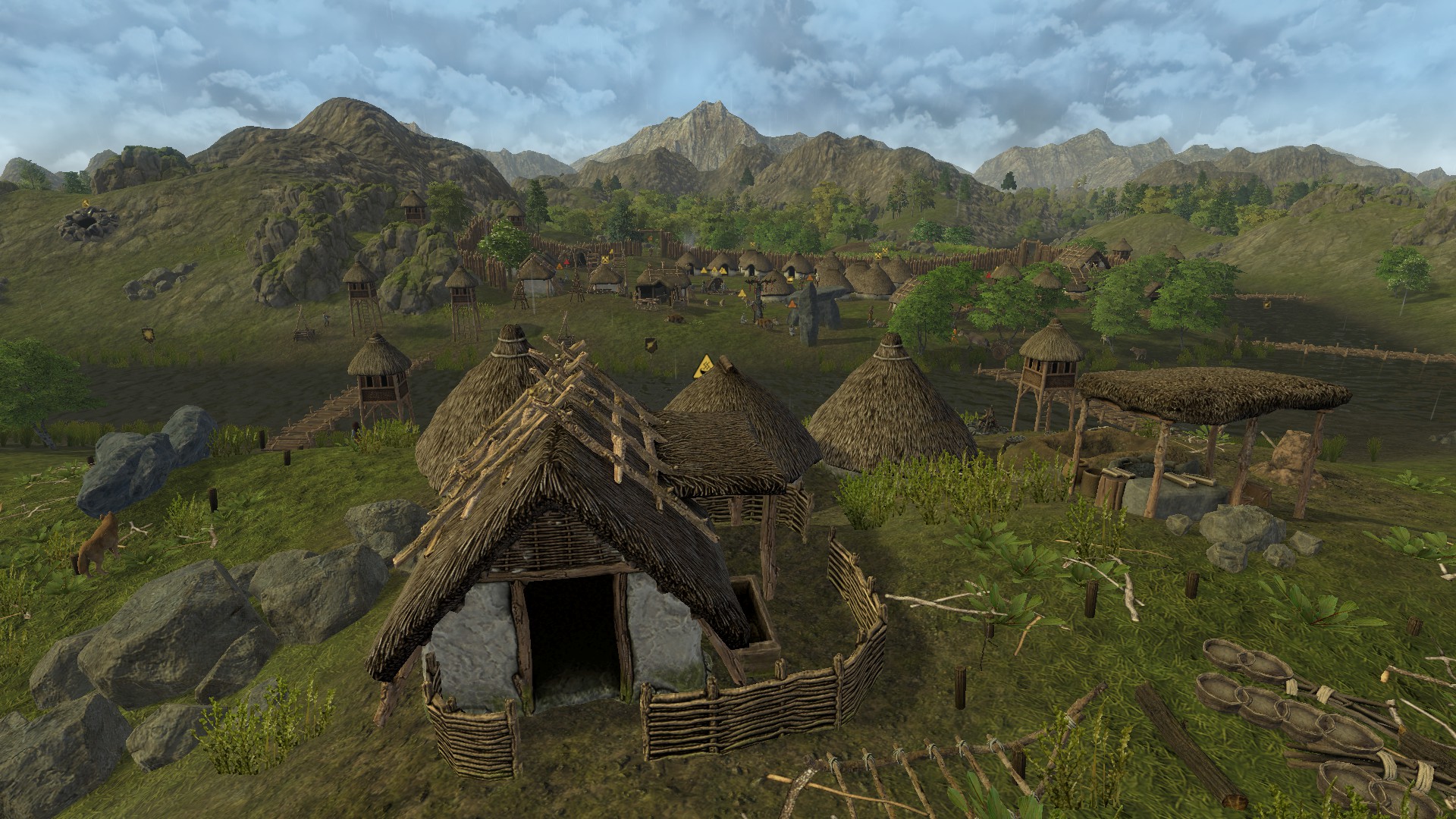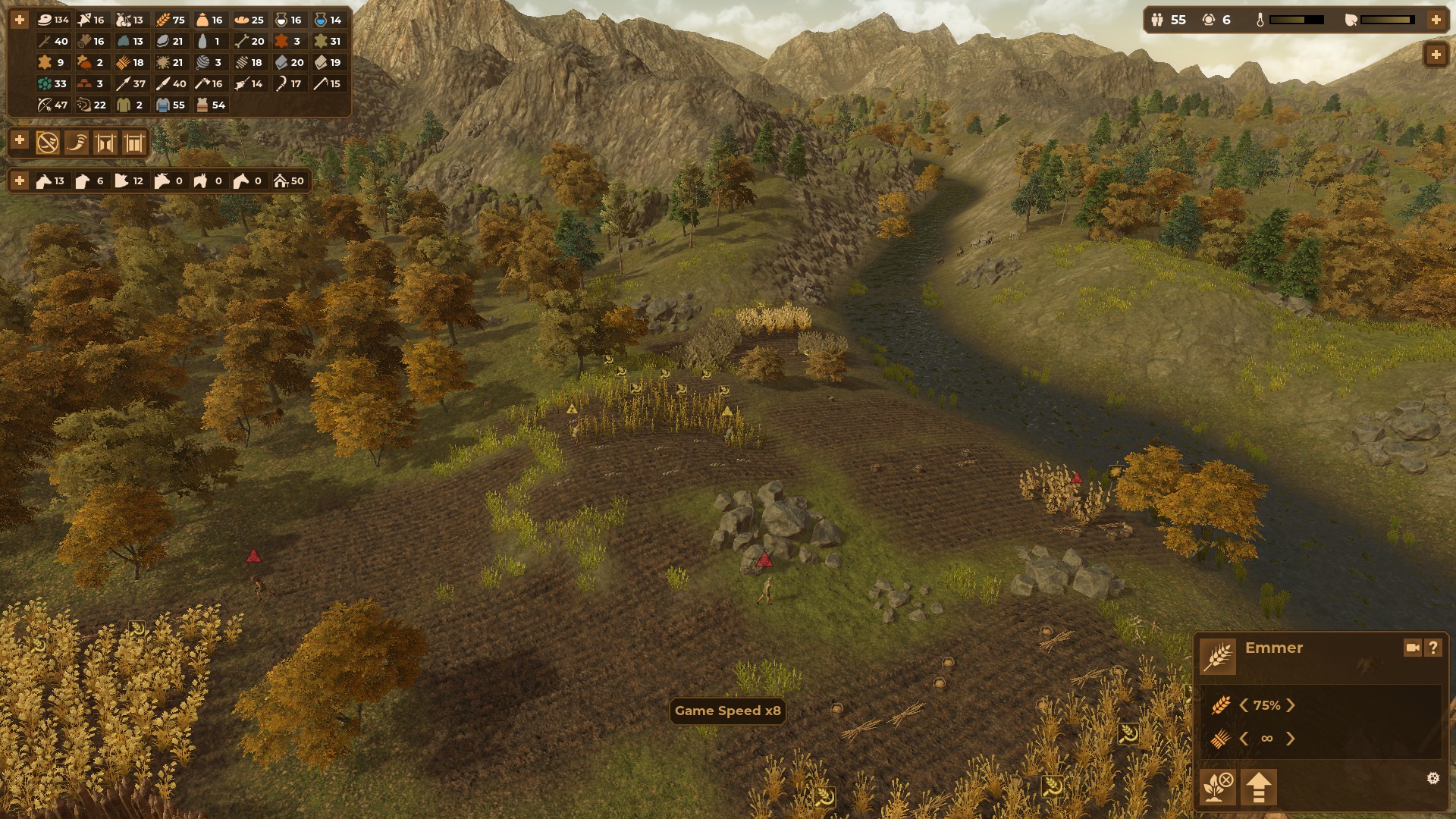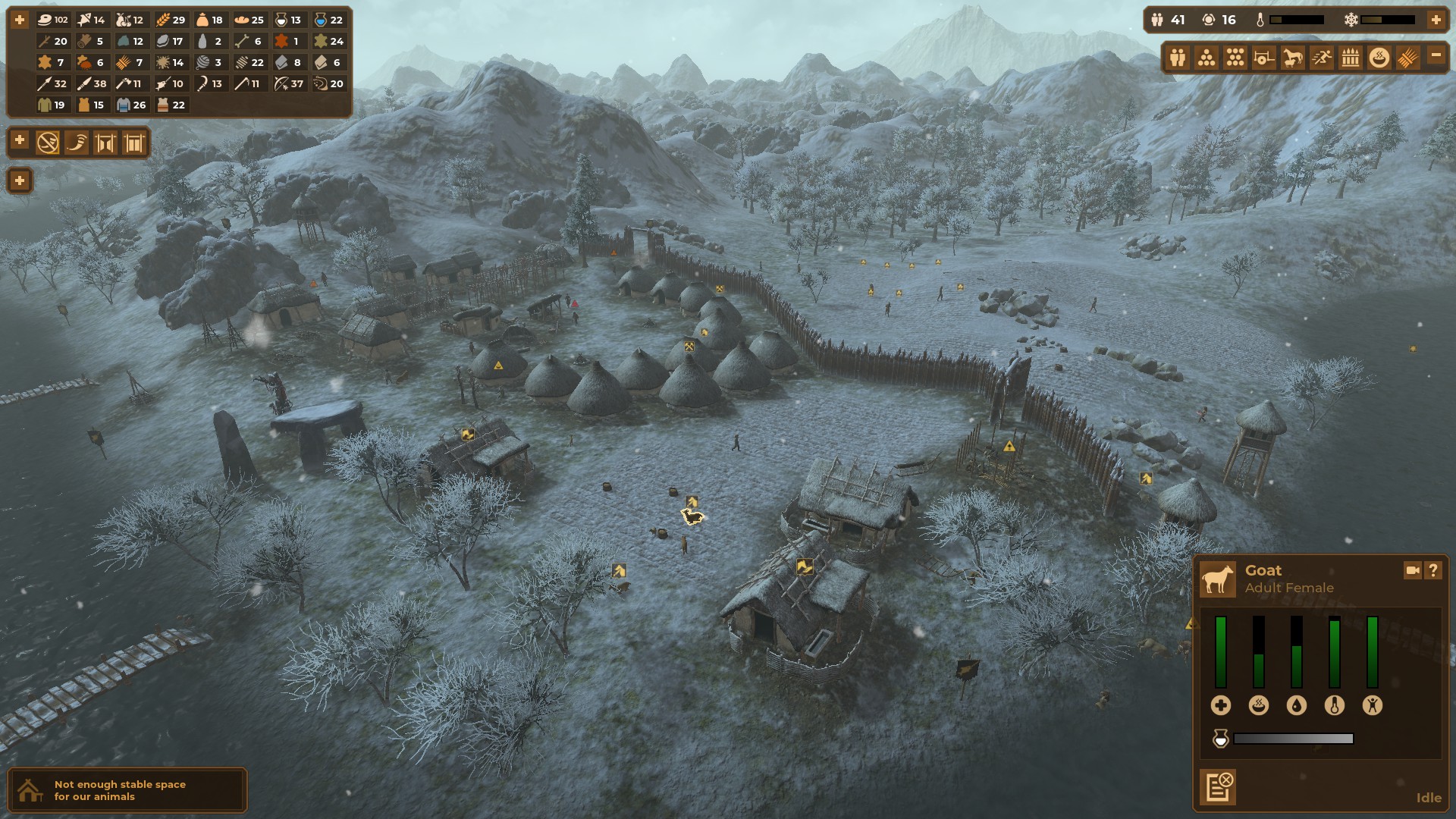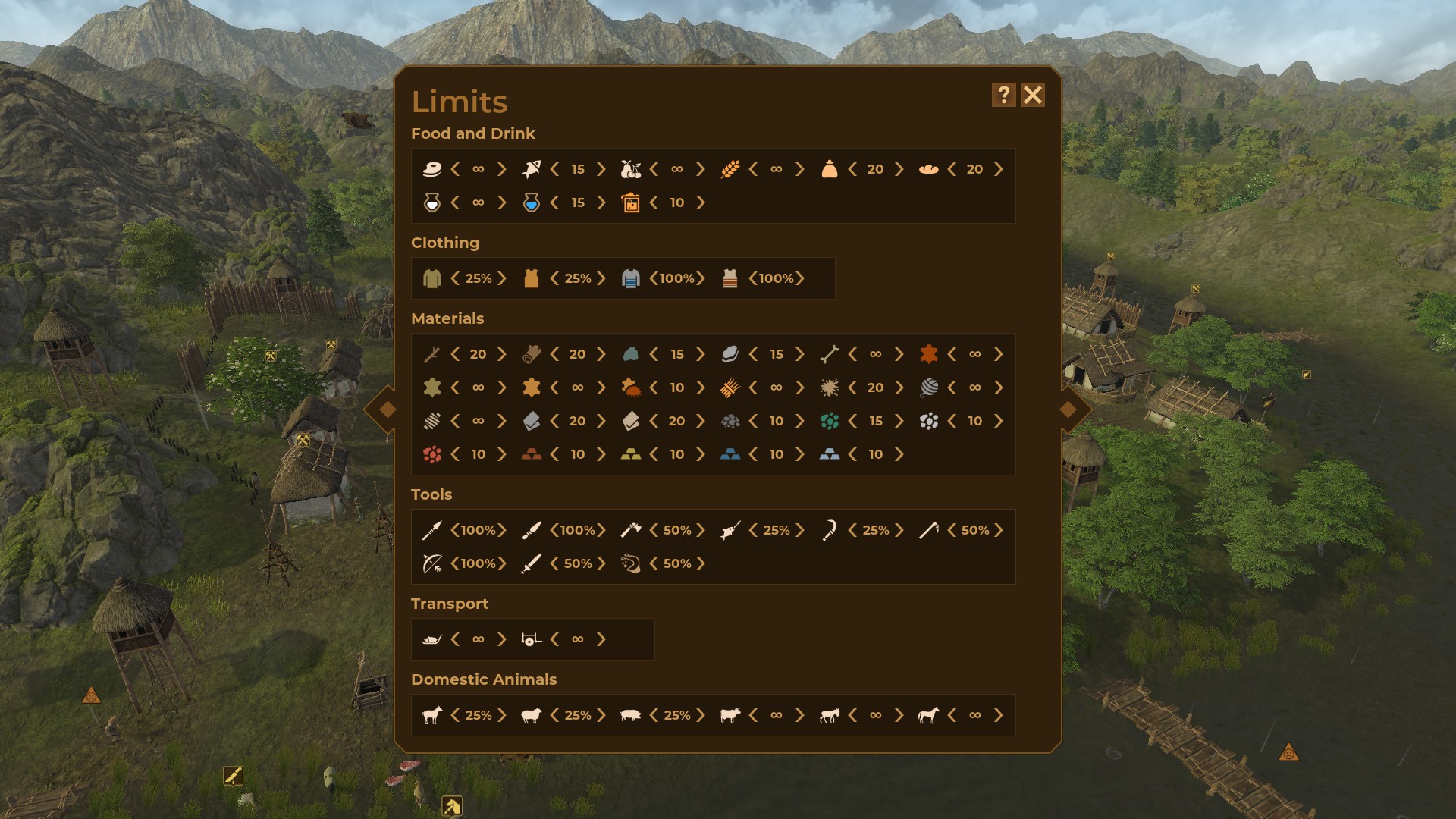Dawn of Man is the ideal city-builder if you hate micromanagement
Thanks to a brilliant automation system, you can set up rules for resources and crafting and then just stick your feet up.

Don’t judge prehistoric sim Dawn of Man by its tangle of menus and occasionally broken AI—beneath its rough exterior is a remarkably streamlined city builder that almost entirely cuts out micromanagement, letting you focus on the things that matter. Like, say, watching a bison headbutt a bear’s ass.
You start each game by instructing your citizens to gather sticks, flint and food from your surroundings. From those materials you can begin to build up your settlement, adding extra huts and a crafting station to create better gear, which you then use to hunt animals for meat. Reaching milestones—such as killing a deer for the first time—nets you knowledge points, which you use to unlock better tech and progress through the Ages, from Stone to Iron. Eventually, you’ll have a fully-functioning town with guard towers, hydropower and donkeys pulling carts.
What I like most about it is the way it handles resource gathering, which you can almost fully automate. You choose certain conditions for both resource collecting and crafting, and if you get the rules right you can leave your townsfolk unattended, only tweaking the formula when you unlock some new tech. It’s a brilliant system, and I wish more city builders had something like it.
To collect materials, you create a circular “work area”, which will automatically tell your citizens to gather a chosen resource type within its bounds. You can decide how big or small you want the circle to be, and generally I found that bigger was better: I placed a wide circle on a huge pile of sticks at the start of my campaign, and my citizens were still picking them up four hours later.

This automation makes Dawn of Man feel unexpectedly and wonderfully relaxing.
Crucially, you can choose the maximum number of people you want gathering in that zone as well as the limit at which they’ll stop collecting. If you create a work zone for chopping trees and set your log limit to 15, then your workers will drop their axes when you hit that number and tend to something more urgent. When supplies run low, they’ll start hacking away again.
Adjusting these numbers lets you prioritise what to collect. In the early game you’re building lots of drying racks out of sticks, so you’ll want to set the limit for sticks quite high to ensure a steady supply. The AI seems smart about how many people it sends—it won’t trigger a whole group to chop down trees when you dip to 14 logs, for example. Townsfolk automatically funnel resources to the right place, dropping their bundles into storage, to your crafter or to a construction area for a new building.
Crafting is similarly hands-off. You can click on an item in the crafting menu—an axe, say—to build one. But if you right click, you’ll set it to continuously produce up to a chosen limit. Handily, the ceiling is based on the percentage of your population, rather than a raw number, which means you don’t need to touch it as your town grows. I set it up so that 75% of my town would always have spears for when raiders attacked, while 50% had bows to fire from watchtowers. When a spear broke, someone immediately headed to the crafting tent to replace it.
The biggest gaming news, reviews and hardware deals
Keep up to date with the most important stories and the best deals, as picked by the PC Gamer team.
For a game about harsh winters, fending off raiders and hunting giant mammoths, this automation makes Dawn of Man feel unexpectedly and wonderfully relaxing. With the resource management and crafting taken care of, you can sit back and wait for the strategic decisions about the next step on your tech tree, or how you want to lay out your growing settlement. I kept being surprised by how efficient my villagers were, and mere minutes after I opened my first copper mine I already had a stack of copper axes in my storage hut.

As someone who hates micromanagement in city builders, it’s a dream.
You’re alerted whenever you need to act, such as when a work area runs out of resources. In that case, you just set up another one with two clicks. It’s easy to switch over production when you find a better version of an item: when I discovered wool outfits, I figured I didn’t need as many tops made of animal skin, which had been keeping everyone warm for past winters. I set wool outfit production to 100%, and dropped skin outfits to 25%, just to keep some spare.
As Chris noted, you can afford to play on 8x speed most of the time, admiring the scenery and watching the cute animations until you’re told something needs your attention. As someone who hates micromanagement in city builders, it’s a dream. I’ve been playing while listening to podcasts and cooking, keeping an ear out for the ‘thunk’ of the notification bar telling me I have business to take care of. If that doesn’t seem like your speed, then there’s a hardcore mode with more aggressive enemies, as well as tougher maps with less resources.
It’s not always perfect, but you can normally figure out how to fix it by digging into the menus. In the third and fourth ages (out of six) you tame animals to produce wool, milk, meat and hide. You can domesticate donkeys, cattle, goats, boars, horses, dogs and sheep—but they all breed like rabbits. My four goats soon became 14, and I was running out of both stable space and straw for them to eat. Plus, my citizens were overworked from having to milk them so often.
What I hadn’t realised is that in the intimidating ‘limits’ panel you can set the maximum number of each animal type, just like any other resource. They’re unlimited by default but I quickly put that right, prompting my citizens to… erm… send the extra goats to another farm far, far away. The same is true for grain: My villagers were neglecting other tasks to sow and reap barley. It felt like half the town were constantly in the fields, until I realised you could limit production to a more manageable level.

Smoothing out these kinks feels like a satisfying puzzle, and the reward is another 15 minutes of downtime. It creates a varied tempo—you’ll intensely manage your village for five minutes working out the perfect combination of rules, leave it alone for a while and watch the numbers tick up, and then dive back in when you get a new unlock. Sometimes simply watching a city builder run is the best part.
The one thing it doesn’t work for is hunting. You can set up a hunting work area, but it only triggers if animals wander into it. A hunting zone can't be large enough to see much action, and invariably your hunters will be doing something else, so by the time they grab their spears the reindeer are halfway across the map. What it really needs is the ability to scout in a large area, keeping one or two people alert so that they can instantly jump on any nearby wildlife
I’m hopeful that the dev team at Madruga Works can add that feature. They seem to be clued up on what doesn't quite work in Dawn of Man, and the latest test branch adds more signposting for animal limits, which would’ve spared me the hassle I described earlier. If they can sort out hunting then it’ll be close to my ideal city builder—set the rules, sit back and watch with satisfaction as your civilization thrives and the woolly mammoths go extinct.
Samuel Horti is a long-time freelance writer for PC Gamer based in the UK, who loves RPGs and making long lists of games he'll never have time to play.


